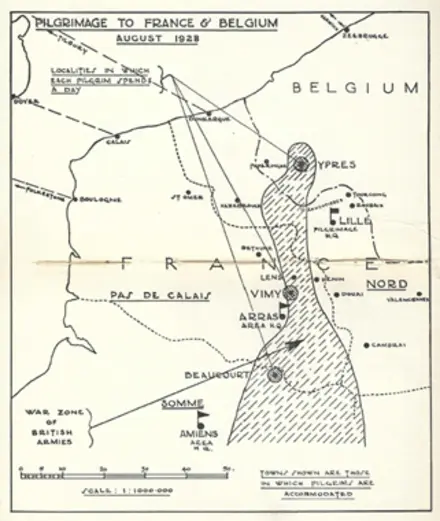In 1928, a decade after the end of the First World War, the British Legion took 11,000 veterans and war widows to the battlefields of Europe where their comrades and loved ones had lost their lives.
The event, known as the Great Pilgrimage, allowed family members to visit the graves of their husbands, sons, fathers, and brothers for the first time since the war had ended.
The commemorations began with ceremonies in Paris where the Chairman of the British Legion attended the Rekindling of the Flame on the Tomb of the French Unknown Warrior, under the Arc de Triomphe, where he laid a wreath. Delegates were also welcomed in Brussels where, similarly, a wreath was laid on the Tomb of the Unknown Warrior there. Local ceremonies were held in various towns across northern France where pilgrims were accommodated including in Lille where HRH the Prince of Wales, a pilgrim himself, dressed in his medals and British Legion badge.


Crossing from English ports into Europe in August 1928
From 4 to 5 August 1928, the pilgrims crossed from English ports into Europe where they became part of the tours of key battlefields in France and Belgium.
Special train services and ferries were organised to transport the attendees who were housed by local French families, or at local schools, when they reached their destination. The host families reported sincere admiration for the men and women they welcomed into their homes and many friendships were forged through the coming together of ordinary people in a common cause.
The battlefields of Vimy Ridge were visited by all pilgrims as it was such a key position in the history of the First World War. The nearby towns are home to war cemeteries for British and Canadian soldiers who died here between Summer 1916 and April 1917 when the Ridge was finally captured. Trains arrived on 6 August 1928, carrying the 11,000 men and women of the British Legion before they split into their touring groups: some visiting the Ridge, others visiting the cemeteries. The Vimy village band greeted each train with an ongoing rendition of ‘God Save The Queen’ and mayors of all the nearby towns met with Colonel Crossfield (British Legion Chairman) on the Ridge where he thanked them for all they had done to welcome the British visitors. Almost every pilgrim who had wanted to find a specific grave managed to do so; one woman finding her son’s headstone which had been recorded in the War Graves Commission with a spelling error, so she had not known the exact location until that day.
Similarly, at Beaucourt-sur-Ancre, 5,000 pilgrims arrived to visit Thiepval, Y Ravine, Beaumont Hamel, and other places of interest, guided by personnel from the War Graves Commission.
In the Newfoundland Park, trenches had been preserved, and barbed wire, shells, and rifles laid on the ground as if the war had only just ended. With the weather being a hot summer's day, one major concern was how the English would be able to have a refreshing cup of tea. The 1st French Army Corp saved the day by setting up field kitchens and providing 26,000 cups of tea, 23,500 slices of cake, and 7,000 packets of biscuits.




Women in the Great Pilgrimage
Over 3,000 women took part in the Pilgrimage and the Women’s Section had been key organisers of provisions for their interests on the journey, as it was the largest party in attendance.
The women’s group was one of the most diverse in terms of age and physical agility as well as including a large number of individuals who had never been abroad before. Their visits to Vimy and Beaucourt were all the more poignant, being that they were walking on the same ground on which their husbands and sons had walked and died years before. No expense was spared in hiring cars and War Graves specialists to locate each grave for those women trying to find their loved ones to pay their respects and feel close to them once again. On 8 August, the women led the march past in Ypres through the Menin Gate, accompanied by the hundreds of Women’s Section Standards which had also made the journey.
Ypres had been a relatively unknown medieval town in Belgium before the First World War but became a strategically important landmark as it was the route for the German Army to the French coastal ports. With a vast memorial in the form of the Menin Gate, erected in 1927, displaying the names of over 50,000 men whose graves are not known, it was a clear choice for the final scenes of the Great Pilgrimage. The commemorations began with the laying of a wreath by the British Legion’s President followed by a service led by the Archbishop of York. The final spectacle was the March Past consisting firstly of the 11,000 pilgrims, led by the women and Women’s Section, followed by the Divisional Signs of ex-servicemen, and finally, HRH Prince of Wales and the President of the British Legion leading the long columns of Standards through the Gate, taking well over an hour for all to complete. Never before had there been such an endeavour of Remembrance.





